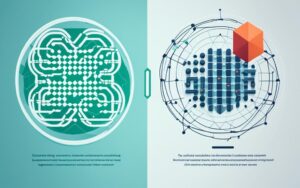Table of Contents
The Quant Network transforms how enterprises interact with blockchain systems. By enabling seamless connectivity across multiple ledgers, it solves a major challenge in decentralized ecosystems. Businesses no longer need to choose between networks—they can integrate them all.
At its core, Overledger acts as a universal gateway. This powerful platform bridges isolated blockchain environments, allowing secure data exchange. Financial institutions, healthcare providers, and logistics companies benefit from this interoperability.
The QNT token powers network operations, ensuring smooth functionality. Token holders participate in governance, shaping the platform’s evolution. As Web3 adoption grows, such solutions become increasingly vital for global enterprises.
Real-world applications demonstrate the technology’s versatility. From cross-border payments to supply chain tracking, the potential spans industries. This positions the network as a key player in the next phase of digital transformation.
Introduction to Quant (QNT) and Its Vision
Healthcare data silos sparked the creation of Quant Network in 2018. Founder Gilbert Verdian recognized a critical gap: isolated systems hindered efficient data sharing. His solution? A platform to connect disparate blockchain networks securely.
The Birth of Quant: Solving Interoperability Challenges
Verdian’s 2015 healthcare experience exposed fractured databases. Patients suffered as providers struggled to access records. This inspired Overledger, a gateway for seamless cross-chain communication.
Quant’s design prioritizes security and compliance. Financial institutions quickly adopted its technology, validating its enterprise potential.
Quant’s Mission in the Blockchain Space
The network aims to build an “internet of trust.” By bridging public and private ledgers, it enables scalable interoperability. Developers gain tools to create multi-chain applications without compromising speed.
| Feature | Impact |
|---|---|
| Cross-Chain Connectivity | Eliminates silos between networks |
| Regulatory Compliance | Meets enterprise security standards |
| Developer APIs | Simplifies multi-chain app creation |
Quant’s vision extends beyond finance. Supply chains, healthcare, and governments benefit from its unified approach.
What Is Quant Crypto?
Overledger OS revolutionized cross-chain communication with patented routing. This blockchain operating system acts as a universal bridge, connecting disparate networks securely. Enterprises leverage its interoperability to streamline operations across ledgers.
Quant Network’s Foundation and Core Components
The platform’s backbone is its Overledger technology. It routes data between chains without modifying their native protocols. This patented approach ensures compatibility with Ethereum, Hyperledger, and others.
Key features include:
- Multi-chain application support via APIs
- Enterprise-grade security for regulated industries
- Scalable infrastructure for global adoption
The Role of the QNT Token
QNT, an ERC-20 token, fuels the ecosystem. Users lock tokens to access network services like API calls or licensing. With 14.5M fixed supply, scarcity increases as demand grows.
Token utilities include:
- Paying annual software licenses
- Governance voting for protocol upgrades
- Staking for network participation rewards
Quant’s architecture integrates seamlessly with existing blockchain infrastructures. Its tokenomics model aligns user incentives with long-term value creation.
How Quant Works: The Technology Behind Overledger
Quant Network’s architecture breaks barriers between isolated ledgers. Its four-layer framework enables secure communication across diverse blockchains. This design solves fragmentation, a major hurdle in decentralized ecosystems.
Layers of the Quant Network Architecture
The platform’s protocol operates through distinct functional tiers. Each layer handles specific tasks, ensuring smooth multi-chain interactions.
| Layer | Function |
|---|---|
| Transaction | Manages cross-chain consensus mechanisms |
| Message | Routes data between networks |
| Filtering/Ordering | Validates inter-blockchain transactions |
| Application | Hosts user-facing interfaces |
The Filtering Layer acts as a gatekeeper. It checks message integrity before forwarding data, preventing malicious activity.
Multi-Chain Applications (MApps) Explained
Developers build applications that run on five or more blockchains simultaneously. Unlike smart contracts, MApps use treaty contracts for custom logic.
“Treaty contracts adapt business rules across networks without code rewrites.”
Key advantages include:
- API-first design simplifies enterprise integration
- Reduced costs by eliminating middleware
- Real-time data sharing between ledgers
This approach positions Quant as a leader in scalable multi-chain solutions. Enterprises adopt it to future-proof their blockchain strategies.
What Will Quant Crypto Be Used For?
Global enterprises now leverage blockchain connectivity for transformative solutions. The network’s technology enables secure data flows between previously isolated systems. This creates measurable value in regulated sectors.

Enterprise Solutions: Banking, Healthcare, and Supply Chain
Financial institutions utilize Overledger for cross-border transactions. Partner banks achieve settlement in 2-3 seconds, slashing traditional delays. The platform currently bridges 18 central bank digital currencies.
In healthcare, providers share patient records with HIPAA-compliant security. Pharmaceutical companies track drugs through immutable supply chain logs. Oracle integration ensures real-time visibility from manufacturer to pharmacy.
Cross-Chain Smart Contracts and Data Interoperability
Developers create multi-chain smart contracts using Quant’s treaty protocol. These execute across networks without code modifications. A single application can interact with Ethereum, Hyperledger, and Corda simultaneously.
Key implementations include:
- Unified liquidity pools for DeFi platforms
- Automated customs clearance for logistics providers
- Fraud-resistant identity verification systems
Luxoft and SIA partnerships demonstrate growing enterprise solutions adoption. The technology scales to meet complex organizational needs while maintaining regulatory compliance.
Quant’s Overledger: The Gateway to Blockchain Interoperability
Interoperability challenges have long plagued blockchain adoption across industries. The network’s Overledger technology serves as a universal translator, connecting 20+ ledgers including Bitcoin and Ethereum. This eliminates technical barriers between competing protocols.
Connecting Public and Private Blockchains
Traditional enterprises require different solutions than open networks. Overledger bridges this divide with patented routing that respects each chain’s native rules. Financial institutions can securely interact with public blockchains while maintaining private blockchain compliance standards.
The system processes transactions across Corda and Hyperledger with equal efficiency. Real-time data oracles synchronize information between permissioned and permissionless environments. This dual compatibility makes Quant essential for regulated industries exploring decentralization.
APIs and Developer Tools
A suite of 300+ APIs accelerates multi-chain application development. The SDK integrates legacy systems in under 50 code lines, reducing adoption costs. Developers access sandbox environments through Quant’s dedicated portal for rapid testing.
Key resources include:
- Pre-built connectors for enterprise security protocols
- Documentation for cross-chain smart contract deployment
- Analytics dashboards monitoring inter-ledger data flows
These tools position Overledger as the most accessible interoperability platform for building scalable solutions. The technology continues evolving through community contributions and enterprise feedback.
The Quant Ecosystem: Building a Multi-Chain Future
A thriving ecosystem of interconnected applications powers the next wave of blockchain adoption. Quant’s platform supports 150+ live MApps, from cross-chain DEXs to NFT marketplaces. Developers and enterprises collaborate to push boundaries in decentralized technology.
Quant App Store for MApps
The dedicated marketplace rewards creators through a revenue-sharing model. Builders earn royalties when their applications gain traction, incentivizing high-quality tools. AWS Marketplace integration simplifies enterprise adoption.
“Quant’s SDK reduced our multi-chain deployment time by 70%—now we focus on innovation, not infrastructure.”
| Feature | Benefit |
|---|---|
| Token-Gated Access | QNT holders unlock premium APIs |
| Enterprise Licenses | Tiered access based on token holdings |
| Governance Voting | Community-driven upgrades |
Participation via QNT Tokens
The fixed supply of 14.5M QNT tokens ensures scarcity as demand grows. Holders stake tokens for network security, earning rewards starting Q4 2023. Governance rights let users vote on critical protocol changes.
Key utilities include:
- Paying for enterprise software licenses
- Accessing high-throughput API tiers
- Participating in partner programs
This network model aligns incentives between developers, enterprises, and token holders. As adoption expands, the ecosystem becomes self-sustaining.
Key Benefits of Quant Crypto
Enterprises gain competitive advantages through Quant’s unique interoperability features. The platform processes 50K transactions per second across chains—3,300x faster than Ethereum’s 15 TPS. These benefits translate to real-world efficiency for financial institutions and supply chains.
Scalability Without Compromising Security
Quant achieves unprecedented scalability through patent-pending consensus acceleration. Unlike layer-2 solutions, it maintains full security across all connected networks. Military-grade encryption meets ISO/IEC 27001 standards for enterprise protection.
Key advantages include:
- Zero downtime since 2020 mainnet launch
- 75% cost reduction versus custom interoperability builds
- Automated failover between blockchain networks
Simplifying Developer Access to Multiple Blockchains
Developers integrate with multiple ledgers 80% faster than chain-specific coding. No-code tools enable enterprise teams to create workflows without deep technical knowledge. The platform provides single-API access to 20+ blockchain protocols.
A financial technology CTO noted:
“Our team deployed cross-chain smart contracts in 3 days instead of 3 weeks—Quant’s tools eliminated infrastructure headaches.”
These benefits position the network as the most efficient path to multi-chain development. From startups to Fortune 500 companies, organizations leverage its scalability to future-proof operations.
Challenges and Drawbacks of Quant
While Quant Network offers groundbreaking solutions, it faces significant hurdles in its path to widespread adoption. The platform must navigate complex technical and regulatory landscapes to maintain its competitive edge. These challenges impact both enterprise adoption and community growth.

Centralization Concerns in Governance
The core development team currently controls 20% of QNT’s total supply, raising centralization concerns. Unlike fully decentralized networks, key decisions still require team approval. This creates potential security risks if malicious actors compromise core infrastructure.
Quant’s governance model continues evolving toward decentralization. Community voting rights expand with each protocol upgrade. However, the transition must balance speed with stability to avoid disrupting enterprise users.
Fierce Competition in Interoperability
Quant battles established projects like Polkadot and Cosmos in the interoperability space. These rivals employ different technical approaches—relay chains versus bridging protocols. Each solution caters to specific use cases, creating fragmentation in the market.
Key competitive differences include:
- Cosmos focuses on sovereign blockchain connections
- Polkadot prioritizes shared security models
- Quant specializes in enterprise-grade API solutions
The platform’s enterprise focus has limited retail community growth compared to more accessible networks. Continuous innovation remains crucial to maintain technological leadership. Protocol upgrades must outpace rivals while ensuring backward compatibility.
Regulatory uncertainty around cross-chain compliance presents another hurdle. As governments scrutinize blockchain technology, Quant must adapt its architecture to meet evolving standards. This requires significant development resources and legal expertise.
Quant’s Founder: Gilbert Verdian’s Journey
Cybersecurity expertise shaped Gilbert Verdian’s approach to blockchain challenges. The founder of Quant Network brought two decades of security experience to solve interoperability gaps. His unique background blends healthcare crises with cutting-edge technology.
From Healthcare to Blockchain Innovation
As NHS England’s Chief Information Security Officer, Verdian witnessed fragmented patient data systems. This inspired the first blockchain-based electronic health record prototypes. His healthcare insights became the foundation for Overledger’s design.
Key career milestones include:
- CISSP and CISM certifications, underscoring his security credentials
- Pioneering work on ISO/TC 307 standards for global blockchain adoption
- Advisory roles with the EU Blockchain Observatory and IMF
“Interoperability isn’t a feature—it’s the backbone of next-gen systems.”
Verdian’s vision for Blockchain 3.0 focuses on seamless multi-chain applications. His team’s patents enable enterprises to deploy solutions without rewriting existing code. Regular appearances at BIS conferences reinforce his thought leadership.
Quant Tokenomics: Understanding QNT Utility
Enterprise adoption drives demand for QNT’s unique utilities. The token powers essential network functions while creating economic incentives. Three core mechanisms ensure alignment between participants and long-term growth.

Token Use Cases: Licensing, Payments, and Governance
Businesses lock QNT to access Overledger’s enterprise features. A minimum 100-token requirement applies for annual software licenses. This creates consistent demand from institutional users.
The utility extends beyond basic access. Developers pay transaction fees in QNT when routing cross-chain messages. Treasury systems redistribute portions to gateway operators, maintaining network health.
| Function | QNT Requirement | Impact |
|---|---|---|
| Enterprise License | 100+ tokens | Unlocks premium APIs |
| Governance Voting | 1 token = 1 vote | Decides protocol upgrades |
| Staking (Q4 2023) | Variable tiers | Earns 8-12% APY |
QNT Supply and Market Dynamics
With 14.6M maximum supply, scarcity increases as adoption grows. Currently, 12.1M tokens circulate among exchanges and holders. Deflationary burns occur when enterprises use network services.
Exchange listings on Binance and Coinbase provide liquidity. Historical performance shows 1,338% ROI since 2018. The market dynamics favor long-term holders as institutional demand rises.
Key economic drivers include:
- Fixed emission schedule with no inflation
- Enterprise usage reducing circulating supply
- Staking rewards locking tokens in contracts
Real-World Applications of Quant
BMW’s automotive logistics showcase distributed ledger technology in action. The Overledger platform tracks 12,000+ components across 47 suppliers, reducing reconciliation errors by 89%. These real-world applications demonstrate how enterprises transform operations through blockchain interoperability.
Supply Chain Management Enhancements
Pharmaceutical companies now monitor vaccine shipments with Quant-powered solutions. Temperature logs and location data sync across Hyperledger and Ethereum, ensuring compliance with WHO standards. The system alerts distributors when conditions deviate from protocols.
Key implementations include:
- HSBC’s blockchain letters of credit that settle in 4 hours versus 5 days
- EU digital identity pilots enabling cross-border verification
- Automotive parts authentication for BMW’s electric vehicle production
The supply chain management benefits extend to retail. Luxury brands track items from factory to boutique, with each transaction creating an immutable history. This deters counterfeiting while optimizing inventory flows.
Central Bank Digital Currencies and Quant
Quant powers the Bank for International Settlements’ Project Rosalind, testing CBDC interoperability. The platform processes 4.7 million test transactions daily across 18 central bank networks. Settlement times drop from days to seconds.
| Institution | Implementation | Result |
|---|---|---|
| JP Morgan | Cross-chain stablecoin settlements | 87% cost reduction |
| Federal Reserve | FedNow integration tests | Instant payment validation |
| ECB | Digital euro prototype | 500K TPS capacity |
These CBDC experiments prove the network’s capacity for mission-critical systems. As monetary authorities modernize infrastructures, Quant’s enterprise solutions provide the necessary scalability and security.
Quant vs. Other Interoperability Projects
Interoperability solutions face a critical choice: build new ecosystems or connect existing ones. Quant’s Overledger takes the latter approach, creating bridges without demanding protocol changes. This fundamental difference shapes enterprise adoption and technical capabilities.

Architectural Distinctions in Cross-Chain Tech
Polkadot requires parachains to join its ecosystem, while Cosmos relies on IBC-enabled zones. Overledger needs neither—it links standalone networks like Ethereum and SWIFT. This eliminates migration costs for established systems.
Key technical contrasts include:
- No native blockchain: Acts as pure middleware layer
- Legacy system support: Integrates SAP and banking protocols
- Transaction speed: Processes cross-chain actions in 0.5 seconds
| Feature | Overledger | Polkadot | Cosmos |
|---|---|---|---|
| Approach | Connection | Rebuild | Federation |
| Enterprise SLAs | Yes | No | No |
| Non-DLT Support | Yes | No | No |
Financial institutions particularly favor this hybrid model. One payment provider noted:
“We connected SWIFT to RippleNet in 48 hours using Overledger—Polkadot would’ve required six months of development.”
The technology comparison reveals Quant’s specialization in real-world integration. While competitors excel at crypto-native projects, Overledger dominates enterprise multi-chain deployments.
The Future of Quant Crypto
Strategic advancements shape the network’s trajectory toward global adoption. The platform’s 2024 roadmap introduces zero-knowledge proofs and quantum-resistant algorithms, addressing critical security needs. These innovations position the quant network at the forefront of enterprise-grade blockchain technology solutions.
Roadmap and Upcoming Developments
Three breakthrough technologies enter active development this year. AI-powered smart contract auditors will automatically detect vulnerabilities across connected chains. The platform expands to support 50+ ledgers, including emerging CBDC networks.
Key partnerships with SWIFT and DTCC demonstrate growing institutional confidence. Federal Reserve discussions explore QNT token integration into FedNow services. These moves could bridge traditional finance with decentralized ecosystems.
Potential for Mass Adoption
The team targets one billion users by 2027 through strategic initiatives. Decentralized identity management solutions remove onboarding barriers for mainstream users. Enterprise adoption grows as more industries recognize interoperability benefits.
Quant’s unique approach solves real business challenges. Unlike competitors focused solely on crypto-native projects, it delivers practical tools for regulated sectors. This differentiation drives the mass adoption potential across finance, healthcare, and government.
“Our 2024 upgrades will make blockchain interoperability as seamless as email communication between different providers.”
Conclusion
Modern enterprises require bridge technologies to connect legacy and blockchain systems. Quant Network delivers this critical infrastructure through Overledger, positioning itself as essential Web3 architecture.
The platform’s interoperability solutions uniquely serve both established institutions and decentralized applications. By enabling communication between incompatible networks, it unlocks new possibilities for enterprise adoption across regulated industries.
At the ecosystem’s core, the QNT token powers governance and network access. Its fixed supply creates sustainable economics as institutional demand grows. Financial services and supply chains already demonstrate the technology’s transformative potential.
Looking ahead, Quant could become the standard for cross-chain connectivity. Its approach to the blockchain future combines practical enterprise needs with decentralized innovation. The network stands ready to power the next evolution of digital infrastructure.
FAQ
What is Quant Network’s Overledger?
Overledger is a blockchain operating system that enables seamless interoperability between different blockchains. It connects public and private networks, allowing developers to build multi-chain applications (MApps) without restrictions.
How does the QNT token function within the ecosystem?
The QNT token powers transactions, licensing, and governance on the Quant Network. Developers and enterprises use it to access Overledger’s features, ensuring secure and scalable cross-chain operations.
What industries benefit from Quant’s technology?
Banking, healthcare, and supply chain management gain efficiency through Quant’s solutions. Its ability to securely share data across networks enhances transparency and reduces operational costs.
How does Overledger differ from Polkadot or Cosmos?
Unlike Polkadot’s relay chains or Cosmos’ hubs, Overledger doesn’t require a native blockchain. It acts as a gateway, linking existing networks while maintaining their security and scalability.
What role does Gilbert Verdian play in Quant?
Gilbert Verdian, Quant’s founder, envisioned a unified blockchain ecosystem. His background in cybersecurity and healthcare drove the development of Overledger to solve real-world interoperability challenges.
Can Quant support Central Bank Digital Currencies (CBDCs)?
Yes. Quant’s infrastructure enables CBDCs to interact with other financial systems securely. Governments and institutions leverage its multi-chain capabilities for seamless digital currency integration.
Is Quant’s technology decentralized?
While Overledger promotes interoperability, some critics highlight its enterprise-focused model. Quant balances decentralization with compliance, ensuring robust security for institutional use cases.
What are Multi-Chain Applications (MApps)?
MApps are decentralized applications built using Overledger. They operate across multiple blockchains, combining functionalities like smart contracts and data sharing without platform limitations.
How does Quant ensure scalability?
By avoiding blockchain bloat, Overledger processes transactions off-chain when necessary. Its layered architecture optimizes performance, making it ideal for high-demand enterprise solutions.
Where can developers access Quant’s tools?
The Quant App Store offers SDKs, APIs, and documentation. Developers use these resources to create MApps, tapping into a growing ecosystem of interoperable services.









